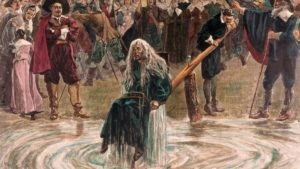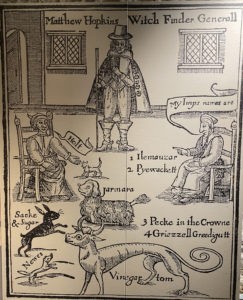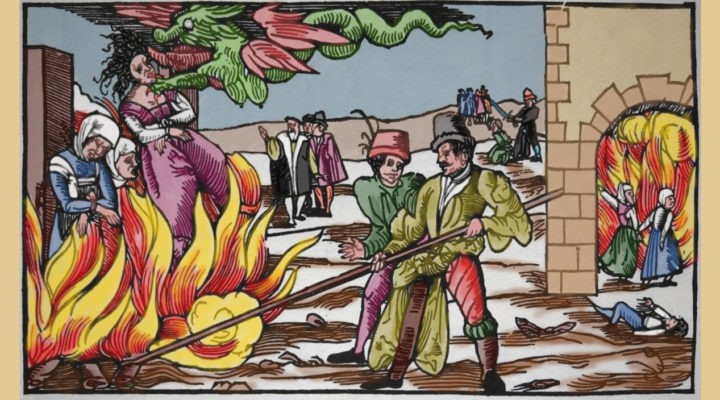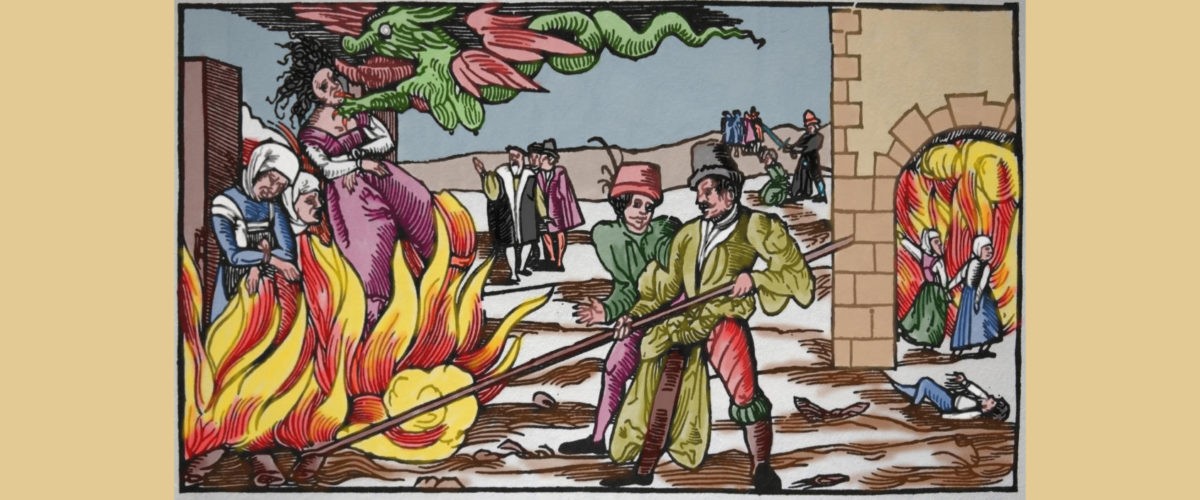It’s that time of the year when the Sanderson sisters come back to our small screens, and little witches run around our neighborhoods with pointed hats and brooms, asking for treats at our doors.
I do love Hocus Pocus as much as the next person, but (and now comes the feminist killjoy) hunting witches is actually no laughing matter. In fact, it’s downright deadly.

Colchester Castle
I’m leading a study abroad in London this fall. One of my classes is on gender, race, class and religion in the UK, and so a couple of weeks ago we talked about Europe’s medieval witch hunts and visited Colchester Castle, the scene of the most witch executions in Britain. From the 15th to 18th centuries, more than 500 people were executed as witches in Britain; estimates suggest 40,000 to 100,000 people were killed across Europe, three-quarters of them women.
Medieval witches
Medieval people deeply believed in witches, and the 1486 publication of Malleus Maleficarum, the Hammer of the Witches, gave them details about how to identify and deal with witches. Specifically, Malleus Maleficarum pointed out that women were more susceptible to witchcraft because of the inherent weakness of their gender. Most importantly, Malleus named witchcraft as a form of heresy and ordered it prosecuted along the lines of the Inquisition.
Those accused of witchcraft, interestingly enough, were most often on the margins of society — women, poor people, older people, odd people who didn’t quite fit in, those with some little resource (like a plot of land) someone wanted to take. Some of these women were traditional healers; they used plants and herbs for healing and may have made potions and cast spells to aid in healing.
Margery Jourdemayne was known in her community as someone who could provide spells and potions for her neighbors to help them find love or get pregnant or end a pregnancy. In 1441, she was accused of using witchcraft in a plot to assassinate King Henry VI. She was found guilty of being a witch and a heretic and was burned at the stake at Smithfield in London.
In Lancashire in 1612, feuding families began to accuse one another of making pacts with the devil. Eventually 19 people were tried, and 10 were found guilty and hanged.
Joan Peterson administered cures for migraines and other small ailments. When a wealthy woman died, Joan was accused of murdering her. Despite a doctor’s testimony that the woman died of an incurable disease and the protests of those who knew Joan, she was hanged for witchcraft at Tyburn in 1652.
Enter the witch-finders

Illustration of a dunking stool for trying witches.
The Malleus also directed witch-finders to use torture to extract a confession from an accused witch. One common method used across Europe was sleep deprivation. Another was the ducking stool. The accused was forced to sit on a chair that was lowered into water. Witch-finders believed that if the accused were guilty, she would float to the top of the water; if she were innocent, she would sink and drown.
King James — yes, the very same one who commissioned the translation of the Bible into English — fancied himself a bit of a theologian and in 1597 wrote Daemonologie, his own guide to witch hunting. He advised witch-finders to look for a mark left by the devil — the “witch’s teat.” This guidance led to invasive searches of women’s bodies, and, while the occasional mark, usually a mole or birthmark, was found on a throat or belly, more than likely they were discovered in the accused’s genitals.
Witch-finders also believed that the devil’s mark could be invisible and discovered only by “pricking.” A whole profession of women “witch prickers” developed who would prick the accused with knives and needles looking for the devil’s mark.

Historical reproduction of Matthew Hopkins’ work as a witch finder.
Little is known about the early life of Puritan Matthew Hopkins until he began his career as a witch-finder in 1644. In 1645, he designated himself Witch-Finder General, although he never was actually appointed by Parliament. He traveled from town to town with his witch prickers to try and examine women for witchcraft, all for a “reasonable price.” Hopkins and his entourage were responsible for around 300 deaths across a two-year period. In 1647, Hopkins published The Discovery of Witches, a publication that later influenced witch trials in Salem, Mass.
Over a period of about 300 years, people who considered themselves devout Christians were drawn into a hysteria that led them to torture and brutally kill people for being different.
Misled by sincere belief, agitated by self-proclaimed experts, and engaged in a bit of self-serving behavior, Christians participated in some of the worst atrocities committed against fellow human beings.
Sound familiar?
Modern-day witch hunts
At this contemporary moment, we see commonalities with the times of the witch hunts. Sincere and devout Christians are being misled by self-proclaimed and self-serving leaders who lead them to participate in atrocities that do indeed lead to trauma and even death.
Think I’m exaggerating?
Let’s take COVID. Donald Trump and his cronies misled many Americans into believing that the coronavirus was a “hoax,” that refusing to wear a mask was an assertion of “freedom,” that quack interventions could cure COVID, that Anthony Fauci was a liar, that the vaccine couldn’t be trusted. Researchers at Columbia University said that between 130,000 and 200,000 COVID deaths were the result of the government’s “abject failures.” We also know that the people most vulnerable to this misinformation were white evangelical Christians.

Marker at Colchester Castle
Another example is “conversion therapy” — a refuted practice of trying to change someone’s sexual or gender identity. While many believers genuinely believe people can “pray the gay away” and change their sexual or gender identity, many LGBTQ people who have experienced conversion therapy have found it torturous and traumatizing. And it doesn’t work. In fact, research shows that conversion therapy is linked to depression, increased substance abuse, and more serious suicide attempts. Yet, around 700,000 LGBTQ people have undergone this process.
Abortion access is another issue where ideology trumps reality. We know what lowers abortion rates — access to contraception, accurate sex education, women’s economic and personal empowerment, and access to affordable, legal, safe abortion. That’s right. Abortion access actually helps lower abortion rates. About 68,000 women worldwide die each year from unsafe abortions; the more restrictive a country’s abortion laws, the more likely women will die from unsafe abortions. Alabama should take heed.
How many Christians held up signs that said “All Lives Matter” or “Blue Lives Matter” in response to 2020’s Black Lives Matter protests after the killing of George Floyd and Breonna Taylor? Yet we know that Black people are disproportionately killed by police and disproportionately incarcerated.
We watched Christians join white nationalists and other hate groups in an insurrection to overthrow the American government. They beat Capitol police officers. They chanted, “Hang Mike Pence.” They searched the Capitol looking for Nancy Pelosi to shoot her. Images of the day show people carrying crosses, waving signs that said, “Jesus Saves,” “Moultrie Co., IL loves Jesus, the Constitution, and Donald Trump,” “Hold the Line Patriots. God Wins.” They had flags that said, “Jesus is My Savior. Trump is My President.” People died that day. Many more were severely injured.
“We are not so far from medieval witch-finders after all.”
At a recent right-wing event sponsored by Turning Point USA, an audience member asked founder Charlie Kirk, “At this point, we’re living under corporate and medical fascism. This is tyranny. When do we get to use the guns?”
He continued, “No, and I’m not — that’s not a joke. I’m not saying it like that. I mean, literally, where’s the line? How many elections are they going to steal before we kill these people?”
We are not so far from medieval witch-finders after all.
Christians dominated by fear
The Bible says that perfect love casts out fear, but we see large swaths of Christianity in the United States dominated by fear, fear of the loss of power, fear of change, fear of difference. And they try to allay that fear by rooting out the people they’re afraid of — powerful women, Black, indigenous, and people of color, LGBTQ people, Muslims, immigrants, moderates and progressives.
“The Bible says that perfect love casts out fear, but we see large swaths of Christianity in the United States dominated by fear.”
I have a sense of “déjà vu all over again” watching the new self-proclaimed conservatives in the Southern Baptist Convention trying to oust the so-called “liberal” and “woke” Southern Baptists who have simply suggested the denomination pay attention to issues of race and sexual abuse. Mind you, most of these people now being targeted for liberalism are the very same people who led the fundamentalist takeover of the convention in the 1980s in an attempt to purge liberals from their midst. I wonder if they see the irony in that.
In this moment of heightened divisiveness, we are all tempted toward greater sectarianism. And let me be clear: I know that we on the Left can also trend toward sectarianism, but I am not going to set up a false equivalency. The Left is not passing laws to discriminate against a group of people, limit voting access or control women’s and LGBTQ bodies; the Left is not dealing in the mire of misinformation and lies; and the Left is not approving of insurrection.
Over and over, we see on the Right messages of fear, especially fear of those who are different. Our responses matter. When people set themselves up as the arbiters of truth with a divine right to dispense judgment, disaster and death are inevitable, as we see in the medieval period and today.
Convinced of their singular grasp of truth, many conservative Christians honestly believe they are keeping us safe, maybe not from witches, but from being overrun by Black and brown hordes, being dominated by angry feminists, being corrupted by lesbians, gay men, bisexuals, transgender and non-binary people, being terrorized by Muslims, losing out to the Other.
But I wonder, whom should we fear most? Witches or witch-finders? People who are different from ourselves? Or the Christians who would torture and kill them?
Susan M. Shaw is professor of women, gender and sexuality studies at Oregon State University in Corvallis, Ore. She also is an ordained Baptist minister and holds master’s and doctoral degrees from Southern Baptist Theological Seminary. Her most recent book is Intersectional Theology: An Introductory Guide, co-authored with Grace Ji-Sun Kim.
Related articles:
Seeing ghosts may cause us to settle account long overdue | Opinion by Greg Jarrell
Happy Halloween, but this year I don’t need anything else to fear | Opinion by Russ Dean


